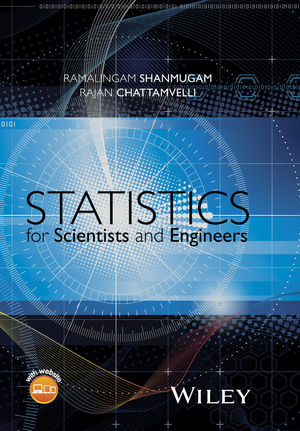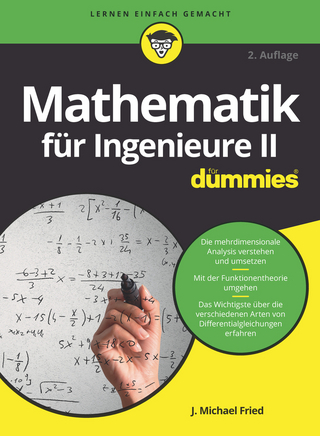
Statistics for Scientists and Engineers
John Wiley & Sons Inc (Verlag)
978-1-118-22896-8 (ISBN)
This book provides the theoretical framework needed to build, analyze and interpret various statistical models. It helps readers choose the correct model, distinguish among various choices that best captures the data, or solve the problem at hand.
This is an introductory textbook on probability and statistics. The authors explain theoretical concepts in a step-by-step manner and provide practical examples. The introductory chapter in this book presents the basic concepts. Next, the authors discuss the measures of location, popular measures of spread, and measures of skewness and kurtosis. Probability theory, discrete distributions, and important continuous distributions that are often encountered in practical applications are analyzed. Mathematical Expectation is covered, along with Generating Functions and Functions of Random Variables. It discusses joint distributions, and novel methods to find the mean deviation of discrete and continuous statistical distributions.
Provides insight on coding complex algorithms using the 'loop unrolling technique'
Covers illuminating discussions on Poisson limit theorem, central limit theorem, mean deviation generating functions, CDF generating function and extensive summary tables
Contains extensive exercises at the end of each chapter and examples from interdisciplinary fields
Statistics for Scientists and Engineers is a great resource for students in engineering, physical sciences, and management, and also practicing engineers who require skill sets to model practical problems in a statistical setting.
Ramalingam Shanmugam is the Editor-in-Chief for the journals: Advances in Life Sciences and Health, International Journal of Research in Medical Sciences, and Global Journal of Research and Review. He is the Book-Review Editor of the Journal of Statistical Computation and Simulation. He directed Statistics Consulting Center in the Mississippi State University. He served the Argonne National Lab., University of Colorado, University of South Alabama and the Indian Statistical Institute. He has published 120 research articles and is a fellow of the International Statistical Institute. Currently, he is a professor in the School of Health Administration, Texas State University. He is a recipient of several research awards from the Texas State University. Rajan Chattamvelli has worked as an Analyst Specialist at Denver Public Health and was a visiting professor at the Indian Institute of Management. He was Chair of the Department of Computer Applications at Presidency College and Periyar Maniammai University, India.
Preface xv
About The Companion Website xxi
1 Descriptive Statistics 1
1.1 Introduction 1
1.2 Statistics as A Scientific Discipline 3
1.3 The NOIR Scale 6
1.4 Population Versus Sample 8
1.5 Combination Notation 11
1.6 Summation Notation 11
1.7 Product Notation 19
1.8 Rising and Falling Factorials 22
1.9 Moments and Cumulants 22
1.10 Data Transformations 23
1.11 Data Discretization 28
1.12 Categorization of Data Discretization 28
1.13 Testing for Normality 34
1.14 Summary 38
2 Measures of Location 43
2.1 Meaning of Location Measure 43
2.2 Measures of Central Tendency 44
2.3 Arithmetic Mean 45
2.4 Median 54
2.5 Quartiles and Percentiles 57
2.6 MODE 58
2.7 Geometric Mean 59
2.8 Harmonic Mean 61
2.9 Which Measure to Use? 63
2.10 Summary 63
3 Measures of Spread 67
3.1 Need For a Spread Measure 67
3.2 RANGE 71
3.3 Inter-Quartile Range (IQR) 73
3.4 The Concept of Degrees of Freedom 74
3.5 Averaged Absolute Deviation (AAD) 76
3.6 Variance and Standard Deviation 77
3.7 Coefficient of Variation 82
3.8 Gini Coefficient 84
3.9 Summary 84
4 Skewness and Kurtosis 89
4.1 Meaning of Skewness 89
4.2 Categorization of Skewness Measures 93
4.3 Measures of Skewness 94
4.4 Concept of Kurtosis 99
4.5 Measures of Kurtosis 102
4.6 Summary 107
5 Probability 111
5.1 Introduction 111
5.2 Probability 112
5.3 Different Ways to Express Probability 114
5.4 Sample Space 119
5.5 Mathematical Background 121
5.6 Events 127
5.7 Event Algebra 132
5.8 Basic Counting Principles 135
5.9 Permutations and Combinations 140
5.10 Principle of Inclusion and Exclusion (PIE) 147
5.11 Recurrence Relations 149
5.12 Urn Models 152
5.13 Partitions 154
5.14 Axiomatic Approach 154
5.15 The Classical Approach 156
5.16 Frequency Approach 166
5.17 Bayes Theorem 168
5.18 Summary 173
6 Discrete Distributions 185
6.1 Discrete Random Variables 185
6.2 Binomial Theorem 186
6.3 Mean Deviation of Discrete Distributions 189
6.4 Bernoulli Distribution 192
6.5 Binomial Distribution 194
6.6 Discrete Uniform Distribution 211
6.7 Geometric Distribution 214
6.8 Negative Binomial Distribution 223
6.9 Poisson Distribution 229
6.10 Hypergeometric Distribution 238
6.11 Negative Hypergeometric Distribution 241
6.12 Beta Binomial Distribution 241
6.13 Logarithmic Series Distribution 242
6.14 Multinomial Distribution 243
6.15 Summary 246
7 Continuous Distributions 255
7.1 Introduction 255
7.2 Mean Deviation of Continuous Distributions 256
7.3 Continuous Uniform Distribution 260
7.4 Exponential Distribution 265
7.5 Beta Distribution 269
7.6 The Incomplete Beta Function 276
7.7 General Beta Distribution 278
7.8 Arc-Sine Distribution 279
7.9 Gamma Distribution 282
7.10 Cosine Distribution 285
7.11 The Normal Distribution 286
7.12 Cauchy Distribution 293
7.13 Inverse Gaussian Distribution 295
7.14 Lognormal Distribution 296
7.15 Pareto Distribution 302
7.16 Double Exponential Distribution 304
7.17 Central chi2 Distribution 307
7.18 Student's T Distribution 310
7.19 Snedecor's F Distribution 315
7.20 Fisher's Z Distribution 317
7.22 Rayleigh Distribution 321
7.23 Chi-Distribution 323
7.24 Maxwell Distribution 324
7.25 Summary 326
8 Mathematical Expectation 333
8.1 Meaning of Expectation 333
8.2 Random Variable 334
8.3 Expectation of Functions of Random Variables 346
8.4 Conditional Expectations 355
8.5 Inverse Moments 361
8.6 Incomplete Moments 362
8.7 Distances as Expected Values 362
8.8 Summary 363
9 Generating Functions 373
9.1 Types of Generating Functions 373
9.2 Probability Generating Functions (PGF) 375
9.3 Generating Functions for CDF (GFCDF) 378
9.4 Generating Functions for Mean Deviation (GFMD) 379
9.5 Moment Generating Functions (MGF) 380
9.6 Characteristic Functions (ChF) 384
9.7 Cumulant Generating Functions (CGF) 387
9.8 Factorial Moment Generating Functions (FMGF) 389
9.9 Conditional Moment Generating Functions (CMGF) 390
9.10 Convergence of Generating Functions 391
9.11 Summary 391
10 Functions of Random Variables 395
10.1 Functions of Random Variables 395
10.2 Distribution of Translations 397
10.3 Distribution of Constant Multiples 397
10.4 Method of Distribution Functions (MoDF) 398
10.5 Change of Variable Technique 401
10.6 Distribution of Squares 403
10.7 Distribution of Square-Roots 404
10.8 Distribution of Reciprocals 406
10.9 Distribution of Minimum and Maximum 406
10.10 Distribution of Trigonometric Functions 407
10.11 Distribution of Transcendental Functions 407
10.12 Transformations of Normal Variates 413
10.13 Summary 414
11 Joint Distributions 417
11.1 Joint and Conditional Distributions 417
11.2 Jacobian of Transformations 421
11.3 Polar Transformations 433
11.4 Summary 438
References 441
Index 455
| Verlagsort | New York |
|---|---|
| Sprache | englisch |
| Maße | 160 x 241 mm |
| Gewicht | 794 g |
| Themenwelt | Mathematik / Informatik ► Mathematik ► Angewandte Mathematik |
| Mathematik / Informatik ► Mathematik ► Statistik | |
| Mathematik / Informatik ► Mathematik ► Wahrscheinlichkeit / Kombinatorik | |
| Technik ► Elektrotechnik / Energietechnik | |
| ISBN-10 | 1-118-22896-0 / 1118228960 |
| ISBN-13 | 978-1-118-22896-8 / 9781118228968 |
| Zustand | Neuware |
| Haben Sie eine Frage zum Produkt? |
aus dem Bereich


